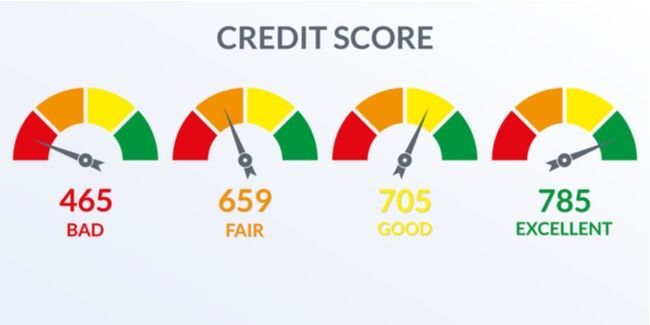What are the three numbers that have a huge effect on your life, from your ability to get a car loan or a mortgage to your chances of being denied rental housing or a job?
I’m talking about your credit score.
If you haven’t given your credit score much thought until now, you need to start tracking your score. After all, there are plenty of tools (both free and not free) for doing so. And most of these apps can help you improve your score.
First, let’s talk about what exactly a credit score is.
What is a credit score?
Since its creation in 1989, the FICO® Score has been the most commonly used assessment of creditworthiness. FICO® Scores are generated by a proprietary scoring algorithm, which empowers lenders to make informed decisions and protects borrowers from unfair bias. This is why FICO® is considered the industry standard.
Credit score range

The base FICO® Score range is 300-850. Higher is better and anything above 600 is generally considered “good.” Lenders equate your score with the level of risk they’d take by extending credit to you. A higher score means lower risk and vice versa.
This is why your credit score is so important, not only for credit approval but also for things like your credit limit and the terms of the loan.
VantageScore
The last thing you should know about credit scores is that, while FICO® Scores are used by the majority of lenders (90%, according to the myFICO site), there are also alternatives.
Why is my score different depending on where I look?
As mentioned above, your credit score may vary slightly depending on the credit agency it comes from and the scoring algorithm used.
For example, the nine-point difference between my two scores could stem from the fact that Equifax reports a slightly longer history and more accounts than TransUnion. This includes an Express Store credit card that I opened in 2002 but haven’t used in more than a decade. There are also more closed accounts listed on my Equifax report.
When you apply for credit, a lender may use a specific score (such as FICO) or an average of your various scores (FICO & Vantage).
So, focus on what you can control: Factors such as your length of credit and payment history and your credit utilization. If a crisis causes your score to go down, you can rebuild it in the same way you would originally create and maintain good standing.
How your score is calculated
According to the myFICO website, your score “summarize[s] your credit history…based on your financial decisions.” As mentioned above, that history is reflected on your three credit reports.
Here are the most common factors used in credit score algorithms:
Number of hard inquiries within the past two years
This is when you apply for a credit card or other type of loan and the lender pulls your credit report as part of the decision-making process. A hard inquiry usually lowers your score, so the more you have, the bigger the impact.
They also remain on credit reports for about two years, so be mindful and strategic when you need to apply for new credit accounts.
Getting pre-approved for a mortgage or credit card is definitely a smart idea. The pre-approval doesn’t lower your credit score and it gives you a better chance of ultimately being approved, so you won’t accrue a hard inquiry in vain.
Number and type of accounts

In order to build a credit history and good credit score, you need to actually use credit. Most young people start out with a retail credit card, student loan, or another type of loan (such as a car loan) that a parent co-signed for.
It’s good to have at least a few accounts (but not too many) and variety is also important. Lenders want to see that you’ve used different types of credit without problems. If you’re looking for your first credit card, check out our article on Best Credit Cards for Young Adults.
Length of credit history
You are limited by your age in this regard, but one thing you can do is keep your oldest accounts open. Even if you don’t want to use your first credit card anymore because you found a better offer, make one purchase on it each month and pay it off to keep it open.
Credit card utilization
Also known as your balance-to-limit ratio, this is simply the percentage of your total credit limit in use at any given time. 30% or lower is the standard figure to aim for.
Higher percentages signal to lenders that you’re having trouble paying off your cards or spending more than you make, both potential risks.
Derogatory marks
These consist of a range of “red flags” from late bill payments to credit accounts in collection and bankruptcy filings. These blemishes can stay on your report for up to a decade, so try to avoid them at all costs.
One easy way to avoid late payments is to sign up for autopay on all of your accounts, from utilities to credit cards.
Payment History
Paying your bills on time is one of the most important ways to build and maintain a good credit score. This isn’t limited to debt payments either. Late payments to a utility or cell phone account can also lower your score.
Where can I find my credit score and report?
Today, checking your credit score is easier than ever. Check out our complete guide to getting your free credit report and score.
Free credit monitoring apps
Or, read our review of Sofi’s Financial Insights Tools, an option we recommend from SoFi with free tools to check and monitor your credit score (and more).
Your credit card
Some banks make your FICO® Score available to you for free as a cardholder perk.
Chase and Capital One credit cards are just two issuers that offer a free credit score with their credit cards.
We recommend checking out our review of the Chase Sapphire Preferred® Card, which also offers 5X points on travel purchased through Chase Ultimate Rewards, 3X points on dining, 2X points on all other travel purchases, and one point per $1 spent on everything else.
Directly from the redit bureaus
Federal law entitles you to a free annual report from each of the three major reporting agencies. However, this doesn’t include a free credit score.
To obtain your score from TransUnion, Experian, or Equifax, you have to sign up for one of their monthly subscription plans. These range in price from about $16.95-$24.95/month. Check out our comprehensive list of credit and identity monitoring services.
Summary
Your credit score is different depending on where you look, but that’s no reason to worry. Just focus on credit-building behaviors and choose a way to view and monitor your score.
Be proactive in maintaining your score and you’ll be in good shape when it comes time to apply for a car or house loan or take advantage of the great credit card offers for people with excellent scores.